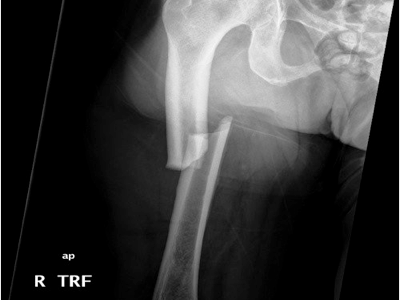
Research Article:
Bisphosphonates and Fractures of the Subtrochanteric or Diaphyseal Femur
Dennis M. Black, et al for the Fracture Intervention Trial and HORIZON Pivotal Fracture Trial Steering Committees.
New England Journal of Medicine. 2010 May 13;362(19):1761-71. Epub 2010 Mar 24.
Background.
Bisphosphonates are a class of drugs commonly prescribed for patients who have osteoporosis and a high risk of fractures. The current FDA-approved medicines include Fosamax (generic alendronate), Boniva, Actonel, and Reclast. These medications help improve bone mass and lower the risk of fractures. Recent concerns have surfaced over possible side effects associated with prolonged use of these drugs. In March 2010, the media profiled women taking bisphosphonates who suffered spontaneous fractures that occur below the hip. These “atypical” fractures occur in shaft of the thigh bone (femur) below the hip are called subtrochanteric or diaphyseal fractures.
Why was the study done?
The reports of the atypical femur fractures have been limited to a few cases and one large study in Denmark that examined all their citizens hospitalized for a fracture and did not find an association with bisphosphonates. The goal for this study was to determine if subjects who participated in drug clinical trials using bisphosphonates sustained atypical fractures.
What did the researchers do and find?
The researchers went back to data collected in three randomized placebo-controlled studies. They utilized two studies using Fosamax, the Fracture Intervention Trial (FIT) and FIT Long-term Extension (FLEX), and Reclast, Health Outcomes and Reduced Incidence with Zoledronic Acid Once Yearly (HORIZON) Pivotal Fracture Trial. Out over 14,000 subjects, a total of 248 hip or femur fractures occurred. Of those only twelve fractures from ten patients were classified as “atypical.” Three of the 10 patients were in the placebo group (received no active drug). Two of the seven on active drug stopped their Fosamax three years before having a fracture. No increase in fractures was observed among women who continued on Fosamax for 10 years.
What do these findings mean?
The results show atypical fractures occurring below the hip in the shaft of the femur rarely happened to the patients taking bisphosphonates up to 10 years of use in the case of Fosamax and three years on Reclast. The benefits of bisphosphonates decreasing osteoporotic fractures far outweigh the risk of rare atypical fractures. More research is still being collected about this issue. The FDA is currently conducting a safety review.
Bottom Line.
Ask your doctor about the medications that you take regularly and reassess their continued use. If you are taking bisphosphonates, inform your physician if you feel any discomfort in your thigh that does not go away. Stay tuned for more information.
Links:
New England Journal of Medicine article online
FDA and safety review
-Diane L. Schneider, MD
________________________________
Image: Atypical femur fracture X-ray courtesy of Dr. Richard Dell
